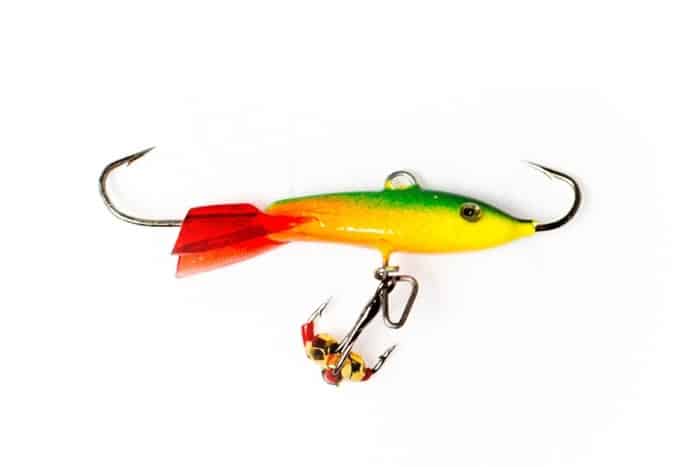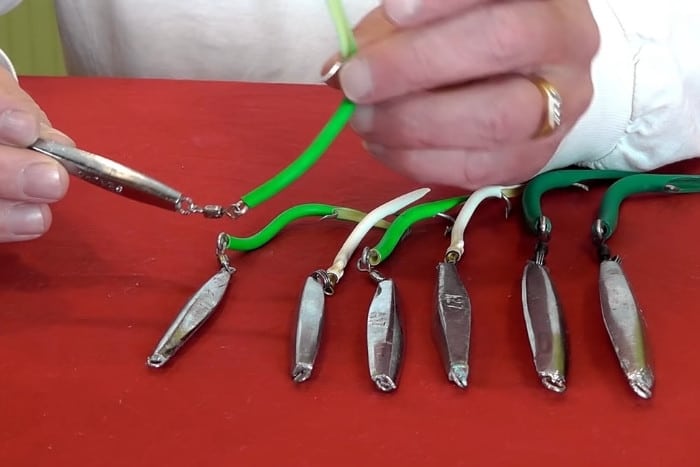Unlike open-water fishing, ice fishing doesn’t require a cavalcade of baits, lures, and tackle to land fish. A collection of a few different types of lures and baits will land you the majority of fish you’re targeting. The trick is being able to locate the fish! Once you do that, a rotation of a few lures is plenty.
The main lures used in ice fishing are usually a jig style of bait. Tungsten jigs, demon jigs, diamond head jigs, and the occasional flutter spoon will work great in most ice fishing situations. The most important feature is that they’re flashy and have enough weight to sink to the bottom.
To give yourself the best chance to land fish, you don’t have to venture far from the classic lures that have worked for years!
Main Lures For Ice Fishing
As anglers, once we find something that works, we like to stick with it. Landing fish isn’t always easy; one effective lure can make all the difference.
Use the following four lures, and you’ll have a great chance at landing your limit.
1. Tungsten Jig
Tungsten jigs are a staple for ice anglers all over the world. Whether you’re targeting panfish, pike, or walleye, they give you a chance at landing just about any species of fish you want.
Using tungsten jigs is crucial because they will be heavier and smaller than a traditional lead jig. Fish love seeing a bait that falls quickly in the water column.
Whether you’re dropping it into the hole for the first time or letting it fall in your jigging motion, the quick sink to the bottom is what the fish want. You’ll consistently see the fish hit the jig as it falls!
A tungsten jig has a smaller, more compact design that isn’t as intimidating for smaller fish but still can entice the larger predators in the area.
They’re small and very receptive to any twitch of your rod. So, if you want a ton of action, you can easily get it with a tungsten jig. If you only want a little, that’s possible as well.
Many anglers choose to put a soft plastic, wax worm, or minnow head on the hook of this jig to make it even more enticing. Depending on the type of fish you’re targeting, this is a helpful strategy.
While the colors of a jig are exciting for a fish in the winter, the jig is even more appealing if it has live bait or a soft plastic attached to the hook.
If you’re using live bait or scented plastic, the action on the jig releases the scent from the bait and moves it around in the column.

2. Flutter Spoon
Any freshwater angler knows the effectiveness of a spoon. If you’re fishing clear or slightly cloudy water, a spoon is an excellent choice for your first bait option.
Spoons are very light, so it takes a while for them to drop in the water column, but as they’re falling, they’re moving water and reflecting any light from the surface.
Panfish, walleye, and pike all love flutter spoons. The color and vibration in the water almost immediately catches the eye of any nearby fish.
Like tungsten jigs, these are best used when you tip them with a minnow or minnow head. While a soft plastic or wax worm would work, minnows consistently do the best on flutter spoons.
Even if you’re new to ice fishing, you’ll notice that fishing with a flutter spoon is straightforward. It’s a matter of using a jigging motion and letting the spoon do the work.
You’ll be the most successful if you can aggressively pull the jig up one or two feet and then let it naturally fall in the water column.
Any aggressive fish in the area will not hesitate to make a run at a falling flutter spoon.
Since the best flutter spoon fishing techniques are somewhat aggressive, you will find fish that match the aggressive energy.
Even more hesitant fish cannot help but come and check out the flutter spoon.
These lures aren’t something they commonly see in the winter, so that amount of action is precisely what they’ve been missing.
Plus, if it’s tipped with a minnow or minnow head, they’ll smell and see it and want a look!
3. Demon Jig
If you like the body of the spoon but the head of a tungsten jig, then the demon jig is the perfect option! It has a beetle-shaped body with all the best features of both lures.
You’ll find that walleye, pike, and panfish love the demon jig.
Like the flutter spoon and tungsten jig, the demon jig is held in high regard by the ice fishing community members. Many argue that there’s no better live bait jig on the market!
The beauty of a demon jig is that you can fish it on a dead stick or an active rod.
A dead stick is another name for the technique of dropping your bait into the water with a slip bobber and letting it sit near the bottom without moving or jigging the rod tip.
Usually, your jig is tipped with a minnow to give it some action without you having to jig it up and down. Demon jigs are great for this because they often glow in the dark and allow the minnow to be active.
You can also jig it like you usually would. Combine the tungsten jig and flutter spoon techniques to get the best results. You can make a bit longer, more aggressive jigs than you would with a tungsten jig.
The weight of the demon jig will allow it to fall faster in the water column than a flutter spoon. Similar to the other two lures, ensure you’re ready as the lure falls. When your bait falls, the aggressive fish strike.
4. Diamond Head Jig
The final lure you may want to use is the diamond head jig. If you like large bluegill, crappie, and trout, then the diamond jig is perfect for you!
All of these fish sit close to the bottom during the winter months, and it’s crucial to be able to reach them when you’re ice fishing.
However, you don’t want the lure you use to get to them to be too large. The diminutive size of a diamond jig can be just what you need. It’s small and even heavier than a traditional tungsten jig.
Where it stands out is its ability to hook into the fish. The hook is offset at around 45 degrees, so if a fish touches it and you sense it, it’ll be hooked!
Another great feature is the bead that’s attached to this jig. The bead is located between the end of the shank and the bend of the hook. This bead is held in place by a small plastic piece.
It’s allowed to move about as you’re jigging up and down. It creates a nice sound that attracts all the fish in the area.
Similar to the other baits listed above, your best bet for success is to tip it with soft plastics, worms, or minnows! The sound of the bead and the bait is a great combination.

Conclusion
While there are dozens and dozens of lures on the market for anglers to use, the above-mentioned options are going to be your best bet. They’re simple designs but are continually effective.
They combine all of the most necessary features of successful ice fishing lures into one design. You want to be able to reach the fish and match their feeding habits with the presentation of your lure.
Since they don’t see flash and movement often throughout the winter months, those lures will attract the attention of all types of fish! It doesn’t matter if the fish are large or small; the lures will work!
